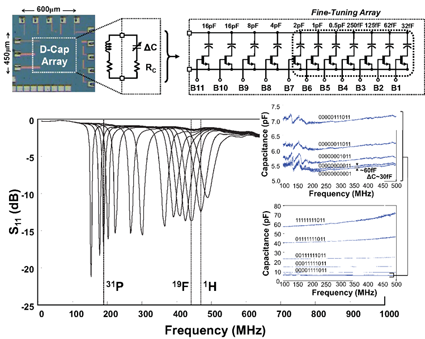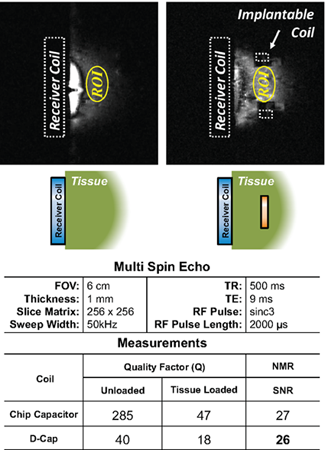Rethinking Capacitors for Nuclear Magnetic Resonance (NMR)
By Walker Turner and Rizwan Bashirullah
An integrated circuit array of capacitors and CMOS transistors provide a precisely adjustable capacitance for wirelessly tuning coils in NMR applications.
NMR imaging and spectroscopy are performed by applying known magnetic fields to align the magnetic dipole moments of the cells within a specific region of interest (ROI) [1]. External coils are then used for the transmission of specific radio-frequency (RF) pulse sequences to cause these dipole moments to resonate, where resonance is a function of the cell’s molecular structure and the applied magnetic field. The magnetic fluctuations generated by these resonating cells are coupled to a precisely tuned receiver coil so cellular information can be acquired with high signal-to-noise (SNR) ratios.
The precise frequency tuning of these resonant coils is critical in high magnetic field NMR applications [2], and is typically accomplished using varactor diodes, discrete components, or trimmable capacitors – a painstakingly slow manual procedure that requires multiple iterations and redesigns. While most NMR coils, such as birdcage resonators and single-loop surface coils, can be tuned in this manner, current implant coil technologies used to non-invasively monitor in-vivo bioengineered tissue constructs can only be tuned through loosely coupling an external surface coil to it [3]. This method provides limited frequency tuning range not suitable for acquisition of a sufficient metabolic signature since each NMR frequency corresponds to a specific biologically relevant nucleus (i.e. Phosphorus, Hydrogen, and Fluorine).
Custom circuitry capable of providing high-resolution wireless programming of its effective output capacitance can replace the discrete capacitors within resonant implant coils to achieve precise frequency tuning using the NMR excitation signals without any modification to the system hardware. Current advances in CMOS integrated circuit (IC) technology offer unparalleled processing and computational capabilities ideal for biomedical applications since numerous functions can be performed within an extremely small footprint. With feature sizes capable of sub-micron resolution; IC technology is being used to develop a wireless electronic device that is smaller than the size of a single discrete electrical component and is capable of boosting the signal quality of the received NMR measurements through the strongly coupled magnetic resonance effect.
The tuning capability relies on the integrated capacitor array shown in Figure 1 where CMOS transistors with minimum conduction channel lengths are implemented as switches to selectively alter the electrical impedance that is shunted across the implanted coil [4]. Sufficiently high capacitive densities can be achieved on-chip using metal-insulator-metal (MiM) capacitors. The IC is capable of providing 32fF variable capacitance resolution with tuning capabilities spanning a 5.5pF to 64pF capacitance range using an 11-bit digital control word, all within a 450µm x 600µm area. Integration with a wireless receiver system on the same chip allows for wireless power and control of the device by leveraging the readily available power within the RF fields of the NMR environment, thus removing the reliance on a bio-compatible battery as a constant power source to allow for an almost indefinite lifetime. The integrated capacitor array is capable of precisely tuning an implantable 20nH inductive detection coil to the NMR resonant frequencies associated with the 1H, 19F, and 31P isotopes (470MHz, 442MHz, and 190MHz, respectively).

Figure 1: Die micrograph of the integrated capacitor array with corresponding schematic using 130nm CMOS integrated circuit technology. Impedance measurements of the IC show a capacitance tuning range from 5.5pF to 64pF with a 32fF capacitive tuning resolution. The tunability of the implantable coil’s resonant frequency is measured through single port electrical impedance measurements (S11) of a loosely coupled coil with broadband frequency response.

Figure 1: Two dimensional NMR images from a multiple spin echo measurement in an 11.1 Tesla magnetic field strength using a tissue loaded surface coil with comparison to the inclusion of the programmable resonant implant coil. A tissue equivalent phantom with dielectric properties of a mouse abdomen (εr = 63 and ο = 1.3 S/m) was imaged to replicate the effects of tissue loading. Comparison of resonances measured using a broadband coil loosely coupled to an implantable coil with discrete capacitor and the programmable variable capacitor.
Comparison of the increase in measurement quality due to inclusion of the tunable resonant coil was verified through NMR imaging within an 11.1 Tesla magnetic field strength, Figure 2. To simulate a medical imaging scenario, a multiple spin echo pulse sequence was used to reconstruct an image of a tissue equivalent phantom with the electrical characteristics of a mouse’s abdomen. Averaging signal levels of multiple image data points, the SNR within the region of interest was increased by a factor of 62.5% due to the inclusion of the additional resonant coil. While implant coils using discrete capacitors have an inherently higher resonant quality factor, due to the lower effective series resistance, losses occurring from surrounding tissue loading the coil impedance result in similar increases in received SNR for both the discrete and variable capacitive approaches, when compared to using a standard surface coil alone. These results demonstrate the potential in using a programmable capacitive device to achieve multi-resonance within coils to increase NMR measurement signal sensitivity. The ability to wirelessly tune programmable capacitors could find use in other applications such as RF communications and implantable biomedical systems.
For Further Reading
[1] E.M. Haacke, R.W. Brown, M.R. Thompson, and R. Venkatesan, “Magnetic Resonance Imaging: Physical Principles and Sequence Design,” 1999, New York: Wiley-Liss. [2] Roemer PB, Edelstein WA, Hayes CE, et al. “The NMR phased array,” Magnetic Resonance in Medicine 1990;16(2):192-225 [3] N. Volland, T. Mareci, I. Constantinidis and N. Simpson, “Development of an inductively coupled MR coil system for imaging and spectroscopic analysis of an implantable bioartificial construct at 11.1 T,” Magnetic Resonance in Medicine, vol. 63, pp. 998-1006, May. 2010. [4] W. Turner, Z. Xiao, S. Wu, B. Beck, R. Bashirullah, and T. H. Mareci, “Digitally Controlled µ-Chip Capacitor Array for an Implantable Multiple Frequency Coil.” International Society for Magnetic Resonance in Medicine, 2010.






 Nitish V. Thakor is a Professor of Biomedical Engineering at Johns Hopkins University, Baltimore, USA, as well as the Director of the newly formed institute for neurotechnology, SiNAPSE, at the National University of Singapore.
Nitish V. Thakor is a Professor of Biomedical Engineering at Johns Hopkins University, Baltimore, USA, as well as the Director of the newly formed institute for neurotechnology, SiNAPSE, at the National University of Singapore.  J. C. Chiao is a Greene endowed professor and Garrett endowed professor of Electrical Engineering at University of Texas - Arlington...
J. C. Chiao is a Greene endowed professor and Garrett endowed professor of Electrical Engineering at University of Texas - Arlington...  Xu Meng (S'08) received a B.E. degree in electronics and telecomm. in 2006 and a M.S. degree in biomedical engineering in 2008 from the Beijing Institute of Technology...
Xu Meng (S'08) received a B.E. degree in electronics and telecomm. in 2006 and a M.S. degree in biomedical engineering in 2008 from the Beijing Institute of Technology...  D. Kacy Cullen has B.S. and M.S. degrees in mechanical engineering, in 2002, and a Ph.D. degree in biomedical engineering from the Georgia Institute of Technology in Atlanta, GA...
D. Kacy Cullen has B.S. and M.S. degrees in mechanical engineering, in 2002, and a Ph.D. degree in biomedical engineering from the Georgia Institute of Technology in Atlanta, GA...  Mohammad-Reza Tofighi received his B.S.E.E. degree from Sharif University of Technology, Tehran, Iran in 1989, and his M.S.E.E. from Iran University of Science and Technology, Tehran, Iran in 1993.
Mohammad-Reza Tofighi received his B.S.E.E. degree from Sharif University of Technology, Tehran, Iran in 1989, and his M.S.E.E. from Iran University of Science and Technology, Tehran, Iran in 1993.  Arye Rosen received a Masters degree in engineering from Johns Hopkins University, a M.Sc. degree in physiology from Jefferson Medical College, and a Ph.D. degree in electrical engineering from Drexel University...
Arye Rosen received a Masters degree in engineering from Johns Hopkins University, a M.Sc. degree in physiology from Jefferson Medical College, and a Ph.D. degree in electrical engineering from Drexel University...  Walker Turner received B.S. and M.S. degrees in Electrical and Computer Engineering from the University of Florida in 2009 and 2012, respectively.
Walker Turner received B.S. and M.S. degrees in Electrical and Computer Engineering from the University of Florida in 2009 and 2012, respectively.  Dr. Rizwan Bashirullah received a B.S. in Electrical Engineering from the University of Central Florida and M.S. and Ph.D. degrees in Electrical Engineering from North Carolina State University.
Dr. Rizwan Bashirullah received a B.S. in Electrical Engineering from the University of Central Florida and M.S. and Ph.D. degrees in Electrical Engineering from North Carolina State University.  Changzhi Li received a Ph.D. degree in electrical engineering from the University of Florida in 2009.
Changzhi Li received a Ph.D. degree in electrical engineering from the University of Florida in 2009.  Ehsan Yavari received a B.S.E.E. degree from the Ferdowsi University of Mashhad, Mashhad, Iran, and a M.Sc. degree in electronics from Tarbiat Modares University, Tehran, Iran.
Ehsan Yavari received a B.S.E.E. degree from the Ferdowsi University of Mashhad, Mashhad, Iran, and a M.Sc. degree in electronics from Tarbiat Modares University, Tehran, Iran.  Victor M. Lubecke received M.S. and Ph.D. degrees in Electrical Engineering from the California Institute of Technology, and a B.S.E.E. degree from the California State Polytechnic Institute, Pomona.
Victor M. Lubecke received M.S. and Ph.D. degrees in Electrical Engineering from the California Institute of Technology, and a B.S.E.E. degree from the California State Polytechnic Institute, Pomona.  Olga Boric-Lubecke received a M.S. degree from the California Institute of Technology, Pasadena, and a Ph.D. from the University of California at Los Angeles, all in electrical engineering.
Olga Boric-Lubecke received a M.S. degree from the California Institute of Technology, Pasadena, and a Ph.D. from the University of California at Los Angeles, all in electrical engineering.